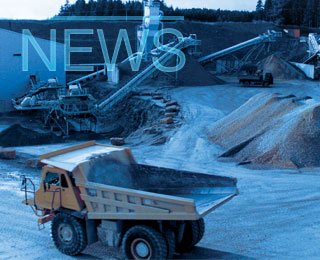HeidelbergCement's first-quarter turnover increased by 7.6% to €2799.4m but the EBITDA declined by 15.5% to €213.7m and the trading profit fell by 77% to a €13.8m. The lower margins chiefly reflect weather conditions in the quarter, but also higher costs for transport and energy. The net interest charge increased by 8.8% to €135.2m and the pre-tax loss increased by 69.8% to €143.9m and the net attributable loss emerged 26.8% higher at €203.8m. Capital investment increased by 4.1% to €159.2m, while spending on acquisitions was €0.1m higher at €2.6m. Net debt was reduced by 2.9% to €8386m to give a gearing level of 63.6%.
Group cement and clinker shipments increased by 5% to 18.21Mt. International trading volumes advanced by 19.5% to 2.5Mt. Total trading activity, which also includes fuel, was 18.1% higher at €168m. Aggregates shipments rose by 1.5% to 47Mt, while ready-mixed concrete deliveries declined by 3.2% to 8.1Mm³ and the asphalt volume fell by 13.7% to 1.39Mt.
In Western & Northern Europe, turnover declined by 6.3% to €887m and the EBITDA fell by 68.4% to €25m, having jumped from €8m to €79m the previous year. Turnover in cement was down by 8.3% to €356m and the EBITDA margin came back to 4.1% from 12.9%. Cement and clinker deliveries came down by 8.3% to 4.34Mt. Domestic cement deliveries were ahead in the Nordic and Baltic markets and cement exports were increased, but clinker exports were reduced. The cold weather in February meant that the German volumes did not quite match the corresponding quarter last year and British and Benelux volumes were down. Aggregates volumes came off by 6.5% to 16.25Mt and the turnover came off by 2.4% to €184m, with the margin declining from 13.5% to 7.7%. Ready-mixed concrete declined by 12% to 2.7Mm³. Asphalt operations, which are primarily in Great Britain, fell by 21.2%. building products, again largely in Great Britain, saw volumes declining, with turnover stable at €104m and the margin improving further from 6.4% to 7.9%.
Eastern Europe & Central Asia reported a 4.4% improvement in turnover to €195m, but the EBITDA loss increased from €2m to €9m. Cement turnover improved by 11% to €154m but the EBITDA margin dropped from 2.4% to 1% with cement deliveries increasing by 4.5% to 2.38Mt. That increase was largely on the new Tula works that helped Russian deliveries expand by over 70% and Russian prices showed a 25% advance over the year. Georgia was also ahead and Poland marginally so, in spite of very poor climatic conditions. In aggregates, volumes were off by 3.9% to 2.14Mt and the turnover was off by 2.5% to €13m. Ready-mixed concrete deliveries were down by 15.3% to 0.6Mm³, reflecting the hard winter.
The Asia-Pacific turnover rose by 19.2% to €782m and the EBITDA increased by 10.2% to 177m. In cement, turnover rose by 19.2% to €468m, but the EBITDA margin eased further from 32.2% to 30%. Cement and clinker volumes improved by 12% to 7.05Mt. Indocem in Indonesia increased deliveries by 19.9% in spite of lower exports and a further 2Mt of grinding capacity is under construction. The joint ventures in the Chinese provinces Guangdong and Shaanxi increased cement deliveries while reducing clinker sales. Cement sales in India were off by 1.1% but a substantial increase was achieved in Bangladesh, thanks to the completion of a new grinding mill at Chittagong. Aggregates sales declined by 6.6% to 8.3Mt because of adverse weather conditions hitting volumes in Australia and in Indonesia, but a continued improvement was seen in Malaysia. Heavy rainfalls in Indonesia and in Australia were major contributors to the 8.4% reduction in ready-mixed concrete deliveries to 2.4Mm³. Higher bitumen prices in Malaysia led to a 14.3% reduction in asphalt sales.
North American turnover improved by 17.7% to €616m and the EBITDA loss narrowed by a further 63.6% to €4m. The cement turnover was ahead by 29% to €205m and the volume rose by 25% to 2.32Mt and the EBITDA margin improved from 7.7% to 7.9%. Aggregates shipments increased by 14.9% to 18.47Mt and the turnover advanced by 23.7% to €177m, with the strongest improvements being seen in the North and Canada regions, but volumes declined in the West and South regions. Ready-mixed concrete deliveries rose by 10.3% to 1.22Mm³, with volumes ahead in all regions and particularly so in the North. Asphalt sales were 8.5% higher at just under 0.2Mt. In building products, more concrete pipes were sold, but in concrete roof tiles, concrete products and pressure pipes volumes declined, leaving turnover 1.7% lower at 142m and the EBITDA margin turned slightly negative.
In Africa and the Mediterranean rim, turnover improved by 6.1% to €265m and the EBITDA by 4.1% to €44m. Group cement and clinker sales declined by 2% to 2.19Mt, with the aggregates volume ahead by 0.3% to 3.51Mt as better Israeli volumes made up for the decline in Spain. Ready-mixed concrete deliveries came back by 7.3% to 1.15Mm³, but the small asphalt business increased volumes by 58.9%. Cement shipments in Africa improved by just 1.4% as capacity constraints prevented any increase in volumes in Ghana, the biggest single market there. A further cement mill is being commissioned at Tema later this year, adding 1Mt of annual capacity, as will a 0.5Mta mill in Liberia. The Akçansa joint venture in Turkey suffered from severe winter weather that reduced domestic sales by in excess of 10%. Cement exports were also declined, but clinker exports increased. Total cementitious volume in the period showed a 9.5% reduction.

Swiss cement sales increase in final quarter of 2024
Swiss cement sales fell 4.6 per cent YoY in 2024, amounting to 3.56Mt. Low-carbon cement types a...